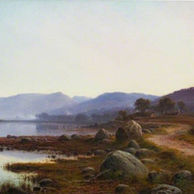
19. Clauchlands / Clach-Lann
Listen to Gaelic translation
The road to Clauchlands Point in Lamlash allows the visitor a perspective on Lamlash Bay which is often overlooked. It gives perhaps one of the best viewpoints of the Holy Isle. A quiet coastal trail, the path can be followed upwards to Dun Fionn, an Iron Age fort which provided several artists a place from which to paint the hills of the north of arran.
This marker on the trail celebrates the work of Victorian painters Waller Hugh Paton, and Sir Joseph Noel Paton, brothers who are associsted with painting in Lamlash. We also celebrate the many generations of the Paton family who have contributed to the cultural life on the island.
Featured Artist
Paton, Waller Hugh

Waller Hugh Paton (1828 - 1895) was born in 1828 in Dunfermline. Essentially self-taught, he was influenced by the Pre–Raphaelites and probably went to Ruskin’s Edinburgh lectures in November 1853 with his brother , Sir Joseph Noel Paton. Waller Hugh is recognised as one the first Scottish Painter to paint outdoors ‘En plein air’.
He was made an Associate of the Royal Scottish Academy in 1857, a member of the Royal Scottish Academy in 1865 and a member of the Royal Scottish Society of Painters in Watercolour in 1878.
A prolific artist and popular in his time, his work deals almost entirely with Scotland (mainly Arran, Perthshire and Aberdeenshire) though he did travel in Europe in the 1860s. His work was noticed by Queen Victoria who asked him to draw Holyrood Palace in 1862.
Waller Hugh Paton worked extensively on Arran and he and his brother did spend at least two summers, 1854 and 1855 working side by side on the island during which time, Noel painted the background for his Pre-Raphaelite work, The Bluidie Tryste.
Waller Hugh Paton was fascinated by the dramatic effects of light, for example, sun reflected on rocks or sunsets and many of his paintings show this. This is illustrated in one of his most famous paintings, Lamlash Bay which is now in the Royal Scottish Academy in Edinburgh. Painted in September 1865 in just under a week, the work is typical of his style, with its purple evening light and depiction of a quiet rural scene.
He died in Edinburgh in 1895.








